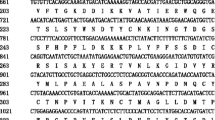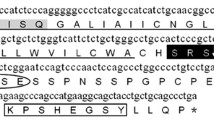Abstract
Aiming to analyze the characteristics of the Cyprinus carpio obese gene structure and the biological activity of its expression product, we amplified the carp obese gene using reverse transcription-polymerase chain reaction from carp mesentery adipose tissue RNA. Sequence analysis revealed that it has a length of 438 nt, which encodes a 146-amino acid peptide. When nucleotide sequence and deduced amino acid sequence were compared with homologous sequences from those of humans, pigs, and rats, they displayed a fairly high degree of conservation (the homology of the nucleotide sequence was 84%, 86%, and 95%, respectively, while that of the amino acid sequence was 84%, 82%, and 96%, respectively, for humans, pigs, and rats). The cDNA fragment was inserted into the expression vector pET-28a, and the resulting plasmid was expressed in Escherichia coli BL21 (DE3) by isopropylthiogalactoside induction. Results of sodium dodecyl sulfate-polyacrylamide gel electrophoresis analysis indicated that a fusion protein was specifically expressed in E. coli BL21 (DE3). The weight of the fusion protein was about 20 kDa, and a 16-kDa protein was expressed from the carp obese gene. By gel thin-layer scanning analysis, the amount of target protein was determined to be about 20%. The purified product was found to be biologically active and to reduce the food intake and body weight of mice during tests.
Similar content being viewed by others
References
Zhang Y. Y., Proence R., Maffei M., Barone M., Leopold L. and Friedman J. F., Positional cloning of the mouse obese gene and its human homologue, Nature, 1994, 372: 453–432
Halaas J. L., Gajiwala K. S., Maffei M., Cohen S. L., Chait B. T., Rabinowitz D., Lallone R. L., Burley S. K. and Friedman J. M., Weight-reducing effects of the plasma protein encoded by the obese gene, Science, 1995, 269: 543–546
Van H. M., Compton D. S., France C. F., Tedesco R. P., Fawzi A. B., Graziano M. P., Sybertz E. J., Strader C. D. and Davis H. R. J., Diet-induced obese mice develop peripheral, but not central, resistance to leptin, J. Clin. Invest., 1997, 99(1): 385–390
Pelleymounter M. A., Cullen M. J., Baker M. B., Hecht R., Winters D., Boone T. and Collins F., Effects of the obese gene product on body weight regulation in obese gene mice, Science, 1995, 269: 540–543
Matarese G., Leptin and immune system: how nutritional status influences the immune response, Eur. Cytokine Netw., 2000, 11: 7–14
Lord G. M., Matarese G., Howard J. K., Baker R. J., Bloom S. R. and Lechler R. I., Leptin modulates the T-cell immune response and reverses starvation-induced immunosuppression, Nature, 1998, 394: 897–901
Dai R. J., Li N. and Wu C. X., Clonins and analysis of pig obese cDNA gene, J. Genet., 2000, 27(4): 290–297 (in Chinese)
Zou M. J., Wang J. X., Wang L. H., Duan J. B., Zhao C. W. and Cai X., Isolation of obese gene and its expression in E. coli, Prog. Biochem. Biophys., 2000, 27(1): 91–94 (in Chinese)
Ramsay T. G., Yan X. and Morrison X., The obesity gene in swine: sequence and expression of porcine leptin, J. Anim. Sci., 1998, 76: 484–490
Johnson R. M., Johnson T. M. and Londraville R. L., Evidence for Leptin expression in fishes, J. Exp. Zool., 2000, 286: 718–724
Muruzabal F. J., Fruhbeck G., Gomez-Ambrosi J., Archanco M. and Burrell M. A., Immunocytochemical detection of leptin in non-mammalian vertebrate stomach, Gen. Comp. Endocrinol., 2002, 128(2): 149–152
Mustonen A. M., Nieminen P. and Hyvarinen H., Leptin, ghrelin, and energy metabolism of the spawning burbot (Lota lota, L.), J. Exp. Zool., 2002, 293(2): 119–126
Stellar E., The physiology of motivation, Psychol. Rev., 1954, 61: 5–22
Liang X. F. and He D. R., Sensory basis in the feeding behavior of fishes, Acta Hydrobiol. Sin., 1998, 22: 278–284 (in Chinese)
Author information
Authors and Affiliations
Corresponding author
Additional information
Translated from Acta Zoologica Sinica, 2005, 51(1) (in Chinese)
Rights and permissions
About this article
Cite this article
Dai, H., Long, L. & Ding, G. Molecular cloning of the obese gene from Cyprinus carpio and its expression in Escherichia coli . Front. Biol. China 1, 50–55 (2006). https://doi.org/10.1007/s11515-005-0013-4
Issue Date:
DOI: https://doi.org/10.1007/s11515-005-0013-4




